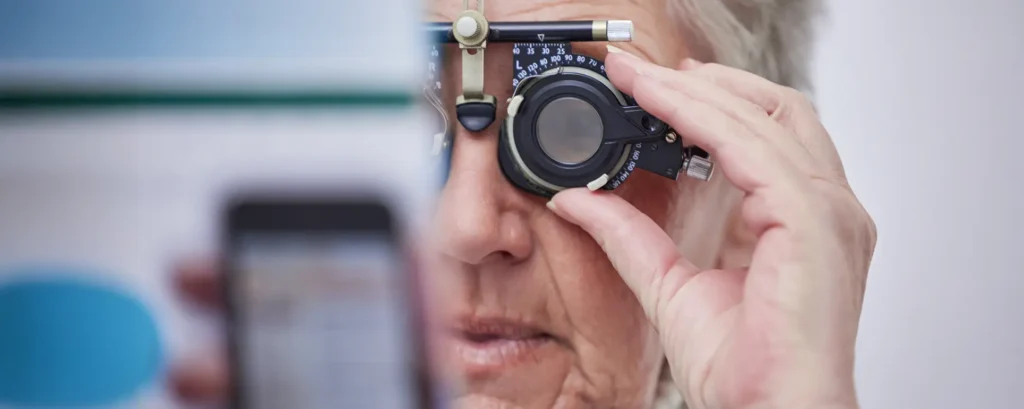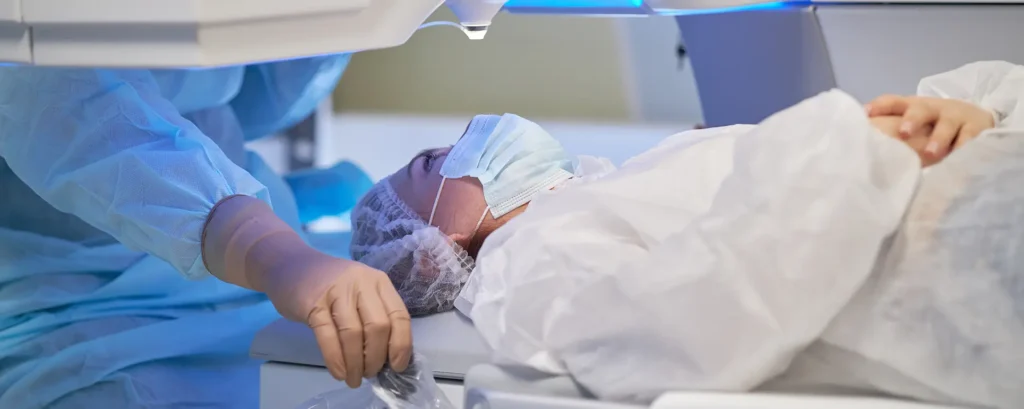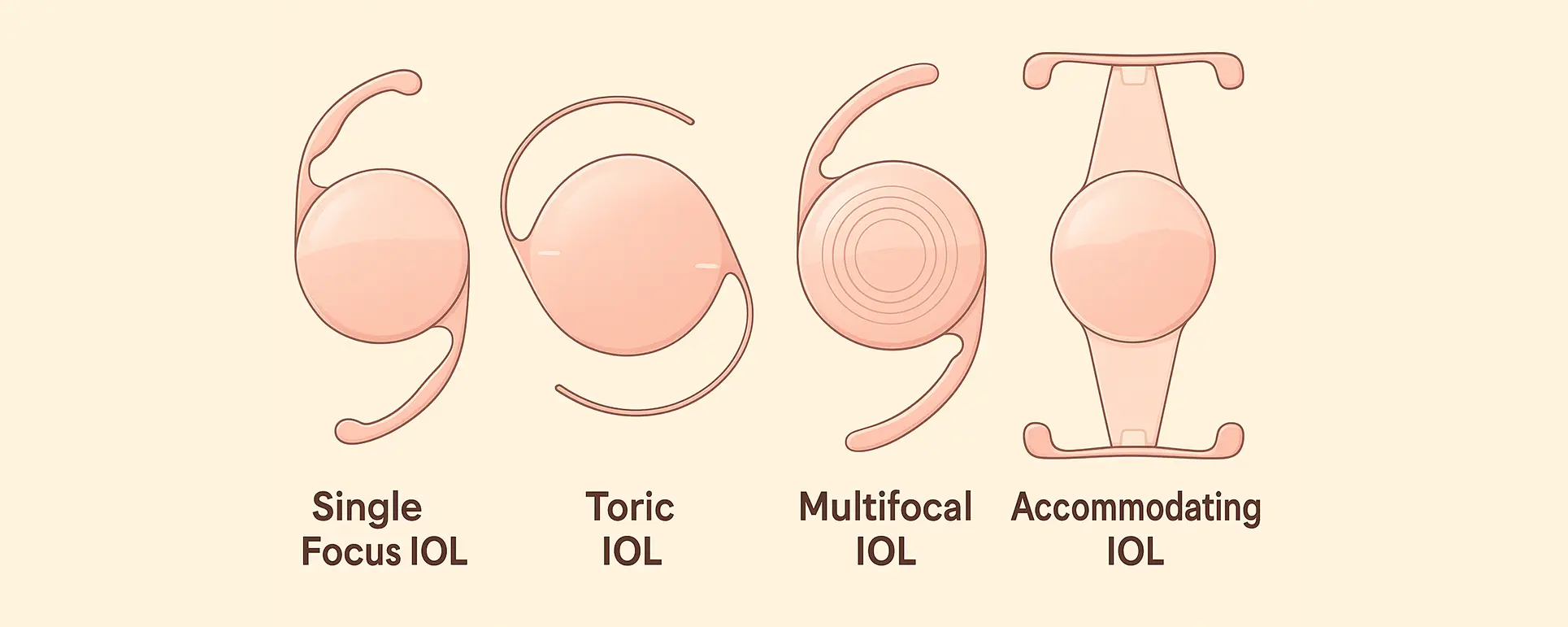If you’re comparing refractive lens exchange (RLE) with cataract surgery, you might be wondering why the lens options look similar but the approach to choosing them feels completely different. Both procedures involve replacing your natural lens with an artificial intraocular lens (IOL), and both can dramatically improve your vision. But the goals, expectations and criteria for choosing the right IOL are not the same, and understanding these differences is essential.
When you’re having cataract surgery, the main focus is restoring clarity and removing a cloudy lens that’s already affecting your daily life. With RLE, the goal is different you’re choosing to replace your natural lens early to gain visual freedom, reduce dependence on glasses and often achieve a sharper, more youthful range of vision. Because your expectations are higher, the precision required during IOL selection becomes even more important.
In this guide, I want to walk you through how surgeons choose lenses for RLE versus cataract surgery, what those differences mean for your outcome, and how you can decide which IOL is right for your eyes. Whether you want the most natural depth of vision, the highest level of spectacle independence or simply the clearest distance vision you can get, this article will help you understand the choices in front of you.
RLE vs Cataract Surgery: The Core Difference
Both procedures replace your natural lens with a synthetic one, but they aren’t performed for the same reason.
Cataract surgery is medically necessary
Your natural lens becomes cloudy, causing glare, haze, blurred detail and difficulty seeing in low light. The priority is to restore clarity and remove the cataract.
RLE is elective
You choose RLE because you want clearer vision without glasses, especially if:
- You’re over 45 and noticing presbyopia
- You want long-term independence from reading glasses
- You’re unsuitable for LASIK or SMILE
- You want to prevent cataracts in the future
Because RLE is chosen for visual optimisation rather than medical necessity, IOL selection becomes more personalised and more demanding.
Why IOL Choice Matters More for RLE

During cataract surgery, most people are simply thankful to see clearly again. But during RLE, your expectations are usually higher because you want:
- Clear distance vision
- Good intermediate vision
- Useful reading vision
- Freedom from glasses
- Minimal visual side effects
- High-quality night vision
Choosing the right IOL is what makes this possible.
Your surgeon looks at your lifestyle, your visual priorities, your corneal shape, your pupil size and your personal tolerance for halos or glare. This level of detail is unique to RLE.
How Surgeons Approach IOL Selection in Cataract Surgery
When you’re having cataract surgery, you usually fall into one of two categories:
1. You want clear distance vision and don’t mind wearing reading glasses
2. You want more independence and choose a premium lens
Because cataract surgery is medically essential, most people choose simplicity.
Common IOL goals in cataract surgery:
- Good distance clarity
- Minimal side effects
- Predictable results
- A comfortable visual transition
- Minimal maintenance
The lens choices tend to be practical rather than lifestyle-driven.
How Surgeons Approach IOL Selection in RLE

RLE stands for “Refractive Lens Exchange,” and the primary goal is refractive precision meaning your IOL choice is designed to give you the best range of unaided vision possible.
Common IOL goals in RLE:
- Maximum clarity
- High precision
- Reduced dependence on glasses
- Optimal range (near–intermediate–distance)
- Full personalisation
- Vision that matches your lifestyle and work needs
RLE demands accuracy because you’re expecting performance, not just visual improvement.
Lens Options: How They Differ Between RLE and Cataract Surgery
Even if the lens types are technically the same, the way they’re recommended varies significantly depending on the procedure you’re having.
Let’s break it down.
1. Monofocal IOLs
Monofocal lenses have one focal point usually distance.
In Cataract Surgery:
Monofocals are the most common choice because they offer:
- Sharp distance clarity
- Minimal halos
- High contrast sensitivity
- Excellent for driving
You’ll still need reading glasses.
In RLE:
Monofocals are used when:
- You prioritise clarity over range
- You don’t mind using glasses
- You have corneal irregularity
- You’ve had previous laser surgery
- You want the most predictable outcome
Monofocal IOLs remain the most accurate option in many complex eyes.
2. Enhanced Monofocal IOLs
Examples: Tecnis Eyhance, RayOne EMV
In Cataract Surgery:
Enhanced monofocals offer a little more intermediate vision, ideal for:
- Dashboard viewing
- Computer work
- Casual reading with bright light
In RLE:
They’re highly popular because they offer:
- Sharper intermediate clarity
- A more natural visual range
- Minimal side effects compared to multifocals
Enhanced monofocals suit people who want more flexibility without the commitment of a multifocal lens.
3. EDOF (Extended-Depth-of-Focus) IOLs
Examples: AcrySof Vivity, Symfony EDOF
In Cataract Surgery:
EDOF lenses appeal to patients who want fewer glasses but dislike multifocals.
In RLE:
They are excellent for:
- Drivers
- Computer users
- People who want lifestyle independence
- Those who want near-natural depth perception
- Those who want fewer halos than trifocals
EDOF IOLs are a middle-ground option between monofocals and multifocals.
4. Multifocal and Trifocal IOLs
Examples: PanOptix, Synergy, FineVision
In Cataract Surgery:
Only a small percentage of people choose these lenses because:
- Nighttime halos are more noticeable
- Contrast sensitivity may be reduced
- They require a healthy cornea
In RLE:
These lenses are far more popular because people choosing RLE typically want:
- Full spectacle independence
- Good reading vision
- A broader visual range
Multifocal and trifocal lenses are highly effective when chosen correctly, but they need:
- A regular cornea
- Good tear film
- Balanced pupil size
- Detailed lifestyle assessment
Not every eye is suitable, especially after previous LASIK or PRK.
5. Monovision Lenses (for RLE Only)
Monovision involves setting one eye for distance and the other for near.
In Cataract Surgery:
Used occasionally but not common.
In RLE:
A popular choice because:
- It gives excellent range
- It feels natural for many patients
- You can try it with contact lenses beforehand
Monovision works particularly well for people with strong reading needs.
Precision: Why RLE Needs More Accurate Measurements
When you’re having RLE, your expectations are higher, so the calculations must be more precise.
Your surgeon will use:
- Optical biometry
- Corneal tomography
- Posterior corneal power mapping
- Wavefront analysis
- Tear film assessment
In RLE:
Even small refractive errors (0.25D) matter.
In Cataract Surgery:
A mild spectacle prescription after surgery is usually acceptable for most people.
Predictability: Post-LASIK Eyes and RLE
If you’ve previously had laser eye surgery, choosing the right IOL becomes even more specialised.
Why?
LASIK, PRK and SMILE change the cornea’s curvature, which affects how formulas calculate your lens power.
In Cataract Surgery:
Monofocal lenses are often chosen for simplicity.
In RLE:
Your surgeon will rely on:
- Barrett True-K
- Haigis-L
- OCT-based formulas
- ASCRS calculation tools
You may also be a strong candidate for a Light-Adjustable Lens (LAL).
Lifestyle Questions Surgeons Ask for RLE (Not Cataract Surgery)
To choose your IOL for RLE, surgeons often ask:
- What distances do you use most (phone, computer, reading)?
- Do you drive at night?
- Are you sensitive to glare?
- Do you prefer sharp distance clarity or reading independence?
- How often do you use digital devices?
- Are you comfortable with monovision?
- Do you want glasses occasionally or not at all?
These questions guide the IOL type.
For cataract surgery, questions are simpler because most people want clear distance vision with reading glasses.
Common IOL Choices: RLE vs Cataract Surgery
Monofocal IOLs:
Suitable for both RLE and cataract surgery, with excellent predictability. They provide sharp vision, especially for distance, and are the most reliable choice for all eyes.
Enhanced Monofocal IOLs:
Highly suitable for RLE and very good for cataract surgery. They improve intermediate vision while maintaining distance clarity, ideal for people who use computers or drive frequently.
EDOF (Extended-Depth-of-Focus) IOLs:
Excellent for RLE and good for cataract surgery. They offer a wider range of vision with fewer halos than multifocal lenses, reducing dependence on glasses.
Multifocal IOLs:
Excellent for selective RLE patients and acceptable for cataract surgery in select cases. They provide near, intermediate, and distance vision but require very regular corneas and healthy eyes.
Trifocal IOLs:
Best for achieving full spectacle independence in RLE. Used in carefully selected cataract surgery cases where high precision is needed for near, intermediate, and distance vision.
Monovision:
Very popular in RLE for providing a full range of vision using one eye for distance and the other for near. Less commonly used in cataract surgery.
Light-Adjustable Lens (LAL):
Outstanding for post-LASIK RLE patients. These lenses allow your surgeon to fine-tune vision after surgery using UV light. Not widely used in standard cataract surgery.
FAQs:
1. Can I undergo RLE if I’ve had previous laser eye surgery like LASIK, PRK, or SMILE?
Yes, having had prior laser eye surgery does not prevent you from undergoing RLE. While the corneal reshaping from previous procedures makes IOL calculations more complex, modern biometry, advanced formulas like Barrett True-K and Haigis-L, and tools such as OCT-based measurements allow surgeons to determine the most accurate lens power. Experienced surgeons can achieve excellent outcomes even in post-laser eyes.
2. How do IOL choices differ between RLE and cataract surgery?
The main difference lies in the goals of the surgery. Cataract surgery focuses on removing a cloudy lens to restore clarity, so the lens selection often prioritises predictability and safety. In contrast, RLE is elective and aims to provide the best unaided vision possible, including intermediate and near vision. As a result, RLE requires more precise measurements, a personalised approach, and consideration of lifestyle needs, whereas cataract surgery decisions are usually simpler.
3. Are multifocal or trifocal IOLs suitable for everyone undergoing RLE?
Not all patients are suitable for multifocal or trifocal lenses. These lenses work best in eyes with regular corneas, balanced pupil sizes, and healthy tear film. Patients with previous corneal irregularities or dry eyes may experience visual disturbances, halos, or reduced contrast. Surgeons carefully assess each eye and lifestyle requirements to determine whether these premium lenses will provide the desired spectacle independence without compromising visual quality.
4. What makes enhanced monofocal and EDOF lenses different from standard monofocals?
Enhanced monofocal and EDOF lenses extend the visual range compared with standard monofocals. Enhanced monofocals improve intermediate vision, making activities like computer work and reading more comfortable. EDOF lenses provide a continuous range from distance to intermediate, reducing the need for glasses while minimising halos and glare that can occur with multifocal lenses. These options are especially appealing for patients choosing RLE because they combine clarity with lifestyle flexibility.
5. How important is precision in IOL measurements for RLE compared to cataract surgery?
Precision is far more critical in RLE than in standard cataract surgery. Since patients are seeking elective visual optimisation, even small errors of 0.25 diopters can impact near or intermediate vision. Surgeons use advanced optical biometry, corneal tomography, wavefront analysis, and posterior corneal mapping to ensure the selected lens power provides the sharpest and most balanced vision. For cataract surgery, minor refractive errors are usually acceptable because the main goal is clarity rather than spectacle independence.
6. Can monovision work effectively for RLE patients?
Yes, monovision can be an excellent solution for RLE patients. This approach sets one eye for distance vision and the other for near, providing a full range of vision without relying heavily on glasses. Patients often trial this setup with contact lenses beforehand to ensure comfort and adaptability. While it is less common in cataract surgery, monovision is popular for RLE because it can achieve functional independence from spectacles across different tasks.
7. Do lifestyle factors affect which IOL is recommended for RLE?
Absolutely. Your daily habits, including computer use, reading, driving at night, and outdoor activities, influence which lens type will deliver the best results. Surgeons take into account how often you use digital devices, your tolerance for glare or halos, and whether you prioritise sharp distance vision or complete reading independence. This personalised approach is a key reason why IOL selection in RLE differs from cataract surgery.
8. Are Light-Adjustable Lenses suitable for all RLE patients?
Light-Adjustable Lenses are particularly beneficial for post-LASIK or post-refractive patients because they allow your surgeon to fine-tune your vision after implantation using UV light treatments. While extremely effective for patients who want precise control over their final vision, they are not commonly used in standard cataract surgery because most cataract patients do not require this level of post-operative adjustment.
9. Can RLE help me achieve complete independence from glasses?
Yes, RLE can significantly reduce or even eliminate the need for glasses, especially when premium lenses like EDOF, multifocal, trifocal, or Light-Adjustable Lenses are used. However, achieving complete independence depends on your corneal health, pupil size, previous surgeries, and visual expectations. Surgeons assess all of these factors to select the lens type that maximises your chances of spectacle-free vision.
10. What should I ask during my RLE consultation about IOL choice?
During your consultation, you should ask how your lifestyle, previous surgeries, corneal shape, and visual priorities affect lens selection. You should also inquire about the expected accuracy of different formulas, whether premium lenses like EDOF or LAL are suitable, and how the surgeon plans to manage potential refractive surprises. Understanding these details helps you make an informed decision and ensures that your chosen lens aligns with your goals for clarity, range, and spectacle independence.
Final Thought: Making the Right IOL Choice
Choosing the right intraocular lens is a key step whether you’re considering RLE or cataract surgery. Cataract surgery focuses on restoring clarity by removing a cloudy lens, while RLE is elective and aims to give you the best possible unaided vision across near, intermediate, and distance ranges. Understanding the differences in lens types, precision requirements, and lifestyle considerations can help you make the right choice for your eyes and your day-to-day life.
If you are thinking about IOL replacement surgery in London, you can get in touch with us at the London Cataract Centre to discuss your options and book a detailed assessment with our experienced team.
References:
1. Lischke, R., Sekundo, W., Wiltfang, R., Bechmann, M., Kreutzer, T.C., Priglinger, S.G., Dirisamer, M. & Luft, N., 2022. IOL Power Calculations and Cataract Surgery in Eyes with Previous Small Incision Lenticule Extraction. Journal of Clinical Medicine, 11(15), p.4418. https://pmc.ncbi.nlm.nih.gov/articles/PMC9369542/
2. Smigiel, R., Kuchle, M., & Sen, C. U., 2025. Innovations in Intraocular Lens Power Calculation A Review. Journal of Clinical Medicine, 14(18), 6585. https://www.mdpi.com/2077-0383/14/18/6585
3. Alshammari, T., Tarazi, A., Aloqaili, T., Aloqaily, M. & AlRyalat, S.A., 2023. Intraocular lens power calculation formulas: a scientometric analysis. Medical Hypotheses, Discoveries & Innovation in Ophthalmology, 12(3), pp.115–126. https://pmc.ncbi.nlm.nih.gov/articles/PMC10926310/
4. Lischke, R., Sekundo, W., Wiltfang, R., Bechmann, M., Kreutzer, T.C., Priglinger, S.G., Dirisamer, M. & Luft, N., 2022. IOL Power Calculations and Cataract Surgery in Eyes with Previous Small Incision Lenticule Extraction. Journal of Clinical Medicine, 11(15), p.4418 https://pmc.ncbi.nlm.nih.gov/articles/PMC9369542/ 5. Chen, D., Ma, X., Liu, M., Lin, X., & Liu, B., 2022. Comparing the accuracy of intraocular lens power calculation formulas using artificial intelligence and traditional formulas in highly myopic patients: a meta-analysis. Ophthalmology. https://pubmed.ncbi.nlm.nih.gov/38904666/

